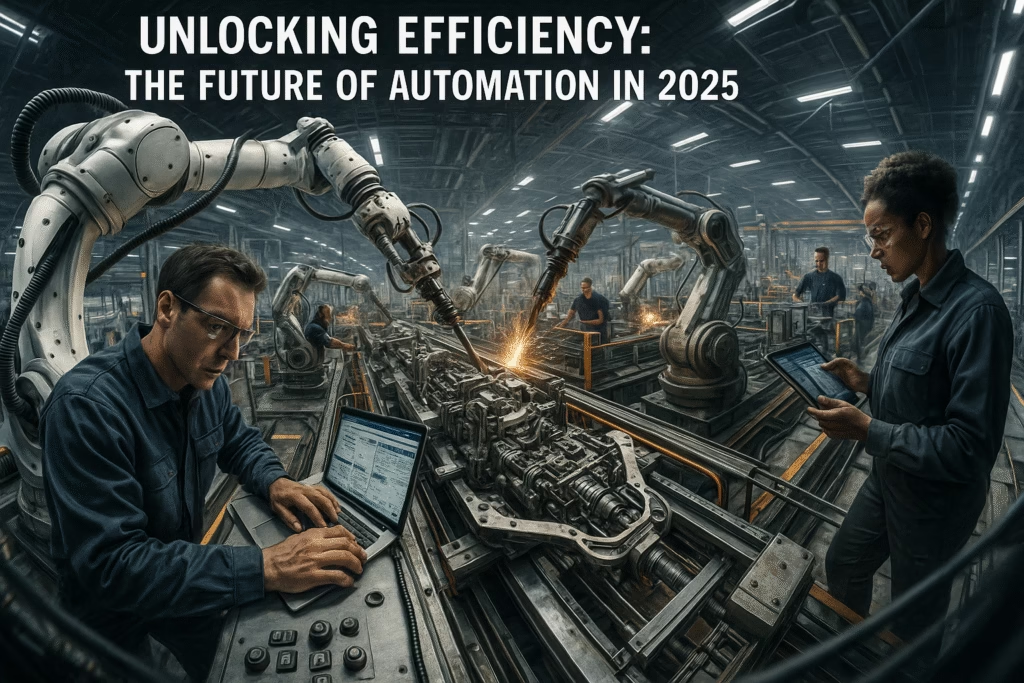Unlocking Efficiency: The Future of Automation in 2025
As we dive into the dynamic landscape of 2025, it’s crucial to recognize the growing significance of task automation in our daily lives and workplaces. The increasing pace of technology development means that automating tasks is not just a luxury but a necessity for maintaining efficiency and productivity. By harnessing advanced automation tools, we can maximize our outputs while minimizing manual efforts. You may wonder, what does the future of automation hold? Let’s explore how task automation will evolve to make our processes more streamlined, efficient, and ultimately more effective.
The Evolution of Task Automation
The journey of task automation has seen remarkable shifts over the years, especially with the rise of artificial intelligence (AI) and machine learning (ML). By 2025, we can expect several trends to further shape the future landscape of task automation.
1. Integration with AI and Machine Learning
AI and ML are the cornerstones of modern task automation. These technologies help analyze data patterns and automate repetitive tasks intelligently.
– Predictive Analysis: Using historical data to foresee upcoming tasks.
– Smart Decision Making: Automating decisions based on data inputs without human intervention.
Companies leveraging AI will likely observe enhanced accuracy and reduced operational costs, as these intelligent systems can learn and adapt swiftly.
2. Increasing Use of No-Code and Low-Code Platforms
No-code and low-code platforms are revolutionizing task automation by enabling users without coding expertise to create automated workflows.
– User-Friendly Interface: Allowing employees to build automations with drag-and-drop features.
– Rapid Deployment: Facilitating quicker turnaround times for new processes.
Platforms like n8n are paving the way for empowering non-developers to implement automation, leading to increased productivity across all levels of an organization. You can learn more about these tools [here](https://n8n.io).
How Task Automation Optimizes Workflows
As businesses increasingly adopt task automation, the positive impacts on workflows become evident. When automation systems are correctly implemented, they enhance efficiency on multiple fronts.
1. Reducing Human Error
Human errors can be costly in any project, causing delays and unnecessary expenditures. Task automation helps mitigate these risks.
– Consistency: Automated processes provide reliable outcomes without variations.
– Error Reduction: Systems designed to execute tasks consistently reduce mistakes significantly.
Eliminating human error allows teams to focus on strategic tasks rather than micromanaging routine deal-breaking errors.
2. Streamlining Communication
Effective communication is vital in today’s fast-paced work environments. Automation can improve this aspect dramatically.
– Automated Notifications: Keeping team members updated on project statuses.
– Task Assignments: Automatically distributing workload based on real-time availability.
By integrating automation in communication, you enhance collaboration and ensure that everyone is on the same page.
The Impact of Automation on Employee Productivity
Adopting task automation fosters an environment where employees can thrive. One significant impact of automation is on workforce productivity.
1. Enhancing Employee Focus
Automating mundane tasks clears the clutter from an employee’s to-do list, allowing them to focus on critical activities that drive value.
– More Time for Innovation: Employees can allocate time towards creative solutions rather than repetitive tasks.
– Job Satisfaction: Engaging in more meaningful work enhances employee morale.
As a result, organizations will likely see an improvement in overall productivity metrics.
2. Flexibility in the Workplace
The nature of workspaces is evolving, with more companies embracing remote working models. Task automation supports this transition.
– Remote Access: Tools and systems can be accessed from anywhere, automating tasks regardless of location.
– Work-Life Balance: Reducing workload through automation helps employees achieve a more balanced lifestyle.
Flexibility in managing work will lead to happier, healthier, and highly engaged employees.
Challenges and Considerations for Implementing Task Automation
Despite its many benefits, implementing task automation is not without its challenges. It’s essential to be aware of potential hurdles.
1. Resistance to Change
The human element is often the biggest barrier to automation.
– Employee Mindset: Employees may feel threatened by the introduction of automation.
– Training Needs: Time and resources must be allocated to train staff in new systems.
Understanding this resistance and preparing for it is crucial as businesses rollout automation initiatives.
2. Data Security and Privacy Concerns
With increased automation comes the significant responsibility of safeguarding sensitive data.
– Data Breaches: Automated systems may become targets for cyberattacks.
– Regulatory Compliance: Ensuring that automated systems comply with legal obligations is critical.
Companies should invest in robust cybersecurity measures to protect against potential vulnerabilities.
The Future Landscape: Trends in Task Automation for 2025 and Beyond
The future of task automation is exceedingly bright, filled with innovations that will further enhance its capabilities. Here are some trends to watch:
1. Hyper-Automation
Hyper-automation involves automating any business process that can be automated. This holistic view on automation includes:
– Artificial Intelligence: Utilizing AI to dynamically evaluate and improve processes.
– Process Mining: Analyzing workflows to identify areas ripe for automation.
This trend will likely define the next decade and create more efficient systems.
2. Automation of IT Processes
IT automation has already made profound impacts, but its role will expand significantly in the coming years.
– Robotic Process Automation (RPA): Automating data entry, configurations, and other IT tasks.
– AI Operations: Utilizing AI to monitor and manage IT infrastructure seamlessly.
These advancements can lead to supreme efficiency in managing IT resources.
Final Thoughts and Next Steps
The trajectory of task automation is clear: it is the future of how we work. By unlocking the power of automation through innovative tools like n8n, organizations can vastly improve their efficiency and employee satisfaction. Embracing AI integration, no-code platforms, and proactive communication strategies will be paramount for harnessing automation’s power.
As you consider adopting task automation in your organization, take time to plan for the challenges and keep your team on board. Explore tools and trainings that suit your business needs and position yourself at the forefront of this exciting transformation. If you’re ready to delve into the world of task automation, visit [khmuhtadin.com](https://khmuhtadin.com) to get started today!


